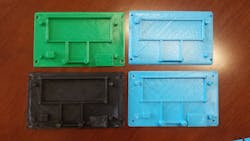3D printing, also known as additive manufacturing, is on the rise and at the center of many controversial debates over its significance and what the future holds for this technology. Although the future scope of 3D printing is currently unknown, one thing is certain: Blacksburg Transit (BT) is at the forefront of this technology in local government and transit services today. BT is actively solving a problem in its industry, while saving money and paving the way for other systems to follow lead.
Tim Witten, Mike Landers, Aneil Samuel and Ignacio Guerrero, who make up BT’s Intelligent Transportation Systems (ITS) Department, did not begin their journey with 3D printing for fun; they had a problem that needed a more efficient solution. The problem was the process of resetting ITS equipment while a bus was in use on the road. The only way to do so involved a time-consuming operation of sending a person out to find the bus with a malfunctioning system and reset it manually. To alleviate this issue, they assembled a network addressable relay that allows the ITS team to communicate across the Internet and is much like a long-range, electronic light switch in that you can turn it on or off remotely. They were then able to troubleshoot equipment and keep it running smoothly without sending someone out into the field.
In-House Problem Solving
For this solution to work, they now needed a suitable case to house this new device since the option they had was not satisfactory for protection or mounting. Through research, the ITS team discovered that they could print and deploy their cases at 20 percent of the cost to have them produced by an outside firm. Therefore, the most cost-effective solution would be to create their own. With that, two 3D printers found a home at BT.
This is a critical fix when you take a look at the big picture; all parts are dependent on what BT is printing. Each electronic remote reset case being made is vital to the functionality of the problem-solving device itself. Without proper housing, the network addressable relay would not work. The equipment that needed to be occasionally reset reports information regarding bus location, schedule adherence and passenger counts. Furthermore, this data is then used to update Blacksburg Transit’s BT4U Mobile App that many riders rely on for accurate departure and trip planning information.
Analysis and Experimentation
The road to perfecting the cases using 3D printers was not without a few potholes. The ITS team tried many different versions of software before coming up with a final model using AutoCAD, commercial software application for 2D and 3D computer-aided design and drafting. Also, cases could be distorted depending on the machine’s calibration and even the temperature of the room, making it no longer usable. The best lesson BT has learned through trial and error with the 3D printers has been exactly that: finding out that this technology can be successful as long as adequate time is put into working with it.
Overall, the pros outweigh the cons when it comes to 3D printing at BT. They are making headway with an exciting, emergent technology that not many in local government, transit or the state of Virginia for that matter, can say the same. In addition, BT’s use of 3D printers is cost effective. Why pay high prices for custom production and shipping with a lengthy wait time when you can just create it yourself, with personalized specifications?
With the ability to print in different colors, densities and sizes, the possibilities for future use are endless.
Fairen Horner is communications & customer support assistant at Blacksburg Transit.
